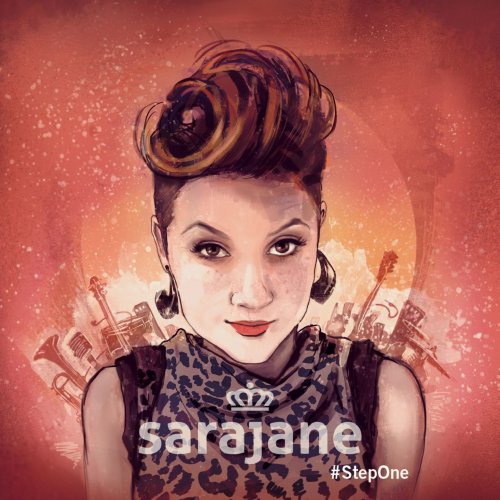
Sarajane - #Step One (2015)
BAND/ARTIST: Sarajane
- Title: #Step One
- Year Of Release: 2015
- Label: McNificent Music
- Genre: Funk, R&B/Soul
- Quality: mp3 320 kbps / flac lossless
- Total Time: 00:54:15
- Total Size: 128 / 367 mb
- WebSite: Album Preview
Tracklist
---------
01. Moving Up
02. Flying
03. Will You Be There
04. Okay
05. It Don't Matter
06. Carousel
07. Wake up Call
08. For You
09. Too Beautiful
10. What Would You Say
11. Let Go
12. Friday Night
13. Maximum
Sarajane, disciple of Gerônimo and Luís Caldas, was the precursor of the mass-media phenomenon known as axé music that broke the phonographic hegemony of the so-called Rio-São Paulo axis, definitively inserting Bahia into the commercial music map. The second woman to become successful as a trio elétrico vocalist (after Baby do Brasil), Sarajane used to walk with Carlinhos Brown (who was only known in the professional milieu) through the ghettos of Salvador BA during the '80s, researching music and dance. During that time she had a band, Bandaid, which blended the music of James Brown and Little Richard with the music from Bahia. Still adolescent, she was walking by the Pelourinho (an indigent borough of Salvador BA, but powerfully rich in terms of music and dance) with her friend, the composer Paulinho Camafeu, when she heard the provocation that would become a national hit: "Pega ela aí! Pra quê? Pra passar batom!" ("Take her! What for? To use lipstick!") Already looking for inspiration in the poor black neighborhoods of the city for her artistic career, she suggested to Camafeu to write a song based on that, and soon he (and Luiz Caldas) came out with "Fricote" (known as "Nega do Cabelo Duro"), which combined calypso, salsa, merengue, rock, and funk. From the beginning the song awakened the anger of the black movement, as its lyrics suggest racism and sexual violence against women. Nevertheless, it was a huge national success from the start, and it was the beginning of axé-music. Sarajane reached the top of the charts in Salvador and won, in 1984, the first Troféu Caymmi (the most important music award in Bahia, now extinct) as best female vocalist. In 1985 she recorded her first LP, Sarajane (EMI-Odeon), which included "Água de Coco" by the still-unknown Carlinhos Brown. The album evidenced Gerônimo's influence in the blending of soca, calypso, merengue, salsa, and funk with traditional rhythms like the samba duro, the samba de roda, cajaxá, and ijexá. After a tour through North and Northeast, she started to make appearances on Chacrinha's broadly popular national TV show (Chacrinha would join a trio elétrico due to her insistence). In 1986 she began to perform in the South, breaking the barrier of prejudice, but soon she was replaced by other popular idols, until the consistent success enjoyed later by Daniela Mercury and Ivete Sangalo, for instance, paid tribute to her pioneering work.
---------
01. Moving Up
02. Flying
03. Will You Be There
04. Okay
05. It Don't Matter
06. Carousel
07. Wake up Call
08. For You
09. Too Beautiful
10. What Would You Say
11. Let Go
12. Friday Night
13. Maximum
Sarajane, disciple of Gerônimo and Luís Caldas, was the precursor of the mass-media phenomenon known as axé music that broke the phonographic hegemony of the so-called Rio-São Paulo axis, definitively inserting Bahia into the commercial music map. The second woman to become successful as a trio elétrico vocalist (after Baby do Brasil), Sarajane used to walk with Carlinhos Brown (who was only known in the professional milieu) through the ghettos of Salvador BA during the '80s, researching music and dance. During that time she had a band, Bandaid, which blended the music of James Brown and Little Richard with the music from Bahia. Still adolescent, she was walking by the Pelourinho (an indigent borough of Salvador BA, but powerfully rich in terms of music and dance) with her friend, the composer Paulinho Camafeu, when she heard the provocation that would become a national hit: "Pega ela aí! Pra quê? Pra passar batom!" ("Take her! What for? To use lipstick!") Already looking for inspiration in the poor black neighborhoods of the city for her artistic career, she suggested to Camafeu to write a song based on that, and soon he (and Luiz Caldas) came out with "Fricote" (known as "Nega do Cabelo Duro"), which combined calypso, salsa, merengue, rock, and funk. From the beginning the song awakened the anger of the black movement, as its lyrics suggest racism and sexual violence against women. Nevertheless, it was a huge national success from the start, and it was the beginning of axé-music. Sarajane reached the top of the charts in Salvador and won, in 1984, the first Troféu Caymmi (the most important music award in Bahia, now extinct) as best female vocalist. In 1985 she recorded her first LP, Sarajane (EMI-Odeon), which included "Água de Coco" by the still-unknown Carlinhos Brown. The album evidenced Gerônimo's influence in the blending of soca, calypso, merengue, salsa, and funk with traditional rhythms like the samba duro, the samba de roda, cajaxá, and ijexá. After a tour through North and Northeast, she started to make appearances on Chacrinha's broadly popular national TV show (Chacrinha would join a trio elétrico due to her insistence). In 1986 she began to perform in the South, breaking the barrier of prejudice, but soon she was replaced by other popular idols, until the consistent success enjoyed later by Daniela Mercury and Ivete Sangalo, for instance, paid tribute to her pioneering work.
Soul | Funk | R&B | FLAC / APE | Mp3
As a ISRA.CLOUD's PREMIUM member you will have the following benefits:
- Unlimited high speed downloads
- Download directly without waiting time
- Unlimited parallel downloads
- Support for download accelerators
- No advertising
- Resume broken downloads


